Advanced Trauma Life Support ATLS Student Course Manual 2018
YUMPU automatically turns print PDFs into web optimized ePapers that Google loves.

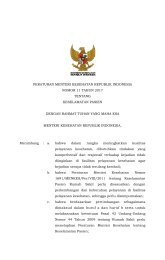
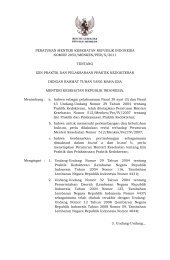
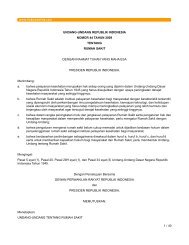

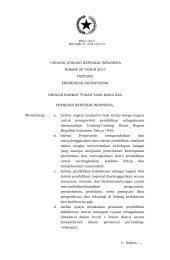
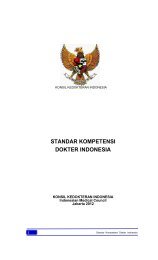

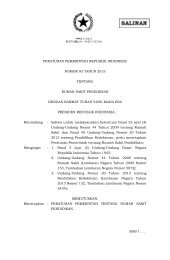

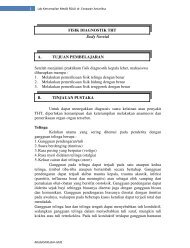
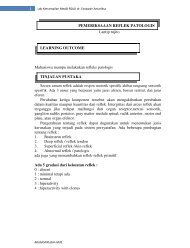
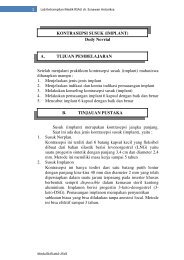
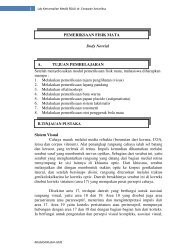
Appendix F TRIAGE SCENARIOS OBJECTIVES 1. Define triage. 3. Apply the principles of triage to actual scenarios. 2. Explain the general principles of triage and the factors that must be considered during the triage process. This is a self-assessment exercise, to be completed before you arrive for the course. Please read through the introductory information on the following pages before reading the individual scenarios and answering the related questions. This content is presented in a group discussion format during the course, and your active participation is expected. At the end of this session, your instructor will review the correct answers. The goal of this exercise is to understand how to apply trauma triage principles in multiple-patient scenarios. Definition of Triage Triage is the process of prioritizing patient treatment during mass-casualty events. Principles of Triage The general principles of triage include: •• Recognize that rescuer safety is the first priority. •• Do the most good for the most patients using available resources. •• Make timely decisions. •• Prepare for triage to occur at multiple levels. •• Know and understand the resources available. •• Plan and rehearse responses with practice drills. •• Determine triage category types in advance. •• Triage is continuous at each level. Safety Comes First By rushing into a scene that is hazardous, responders can risk creating even more casualties—themselves. The goal of rescue is to rapidly extricate individuals from the scene, and generating more injured persons is certainly counterproductive. Triage should only begin when providers will not be injured. Responders must be aware of the possibility of a “second hit” (e.g., further structural collapse, perpetrators, fires, earthquake aftershocks, additional explosions, and additional vehicle collisions). Some scenes may need to be made safe by firemen, search and rescue teams, or law enforcement before medical personnel can enter. Do the Most Good for the Most Patients Using Available Resources The central, guiding principle underlying all other triage principles, rules, and strategies is to do the most good for the most patients, using available resources. Multiple-casualty incidents, by definition, do not exceed the resources available. Mass-casualty events, however, do exceed available medical resources and require triage; the care provider, site, system, and/or facility is unable to manage the number of casualties using standard methods. Standard of care n BACK TO TABLE OF CONTENTS 317
318 APPENDIX F n Triage Scenarios interventions, evacuations, and procedures cannot be completed for each injury for every patient within the usual time frame. Responders apply the principles of triage when the number of casualties exceeds the medical capabilities that are immediately available to provide usual and customary care. Make Timely Decisions Time is of the essence during triage. The most difficult aspect of this process is making medical decisions without complete data. The triage decision maker (or triage officer) must be able to rapidly assess the scene and the numbers of casualties, focus on individual patients for short periods of time, and make immediate triage determinations for each patient. Triage decisions are typically made by deciding which injuries constitute the greatest immediate threat to life. Thus the airway, breathing, circulation, and disability priorities of ATLS are the same priorities used in making triage decisions. In general, airway problems are more rapidly lethal than breathing problems, which are more rapidly lethal than circulation problems, which are more rapidly lethal than neurologic injuries. Trauma team members use all available information, including vital signs when available, to make each triage decision. Triage Occurs at Multiple Levels Triage is not a one-time, one-place event or decision. Triage first occurs at the scene or site of the event as decisions are made regarding which patients to treat first and the sequence in which patients will be evacuated. Triage also typically occurs just outside the hospital to determine where patients will be seen in the facility (e.g., emergency department, operating room, intensive care unit, ward, or clinic). Triage occurs again in the preoperative area as decisions are made regarding the sequence in which patients are taken for operation. Because patients’ conditions may improve or worsen with interventions and time, they may be triaged several times. Know and Understand the Resources Available Optimal triage decisions are made with knowledge and understanding of the available resources at each level or stage of patient care. The triage officer must be knowledgeable and kept abreast of changes in resources. A surgeon with sound knowledge of the local health system may be the ideal triage officer for in-hospital triage positions because he or she understands all components of hospital function, including the operating rooms. This arrangement will not work in situations with limited numbers of surgeons and does not apply to the incident site. As responders arrive at the scene, they will be directed by the incident commander at the scene. For mass-casualty events, a hospital incident commander is responsible for directing the response at the hospital. Planning and Rehearsal Triage must be planned and rehearsed, to the extent possible. Events likely to occur in the local area are a good starting point for mass-casualty planning and rehearsal. For example, simulate a mass-casualty event from an airplane crash if the facility is near a major airport, a chemical spill if near a busy railroad, or an earthquake if in an earthquake zone. Specific rehearsal for each type of disaster is not possible, but broad planning and fine-tuning of facility responses based on practice drills are possible and necessary. Determine Triage Category Types The title and color markings for each triage category should be determined at a system-wide level as part of planning and rehearsal. Many options are used around the world. One common, simple method is to use tags with the colors of a stoplight: red, yellow, and green. Red implies life-threatening injury that requires immediate intervention and/or operation. Yellow implies injuries that may become life- or limb-threatening if care is delayed beyond several hours. Green patients are the walking wounded who have suffered only minor injuries. These patients can sometimes be used to assist with their own care and the care of others. Black is frequently used to mark deceased patients. Many systems add another color, such as blue or gray, for “expectant” patients—those who are so severely injured that, given the current number of casualties requiring care, the decision is made to simply give palliative treatment while first caring for red (and perhaps some yellow) patients. Patients who are classified as expectant due to the severity of their injuries would typically be the first priority in situations in which only two or three casualties require immediate care. However, the rules, protocols, and standards of care change in the face of a mass-casualty event in which providers must “do the most good for the most patients using available resources.” (Also see triage information in Appendix C: Trauma Care in Mass-Casualty, Austere, and Operational Environments and Appendix D: Disaster Preparedness and Response.) n BACK TO TABLE OF CONTENTS
- Page 1 and 2: TENTH EDITION ATLS ® Advanced Trau
- Page 3 and 4: Chair of Committee on Trauma: Ronal
- Page 6: FOREWORD My first exposure to Advan
- Page 9 and 10: viii PREFACE MyATLS Mobile Applicat
- Page 11 and 12: x PREFACE Gary A. Vercruysse, MD, F
- Page 13 and 14: xii PREFACE Jacqueline Bustraan, MS
- Page 16 and 17: ACKNOWLEDGMENTS It is clear that ma
- Page 18 and 19: xvii ACKNOWLEDGMENTS Bertil Bouillo
- Page 20 and 21: xix ACKNOWLEDGMENTS Oscar Guillamon
- Page 22 and 23: xxi ACKNOWLEDGMENTS Mahesh Misra, M
- Page 24 and 25: xxiii ACKNOWLEDGMENTS James Vosswin
- Page 26 and 27: xxv ACKNOWLEDGMENTS James A. Geilin
- Page 28: xxvii ACKNOWLEDGMENTS Tone Slåke R
- Page 31 and 32: xxx COURSE OVERVIEW m. Protection o
- Page 33 and 34: xxxii COURSE OVERVIEW Atls and Trau
- Page 35 and 36: xxxiv COURSE OVERVIEW a systematize
- Page 37 and 38: xxxvi COURSE OVERVIEW 69. Switzerla
- Page 39 and 40: xxxviii COURSE OVERVIEW United Stat
- Page 41 and 42: xl COURSE OVERVIEW 67. Hendrickson
- Page 43 and 44: xlii COURSE OVERVIEW 122. Palusci V
- Page 46: BRIEF CONTENTS Foreword Preface Ack
- Page 49 and 50: xlviii DETAILED CONTENTS Teamwork 5
- Page 51: l DETAILED CONTENTS Introduction 21
- Page 55 and 56: 1 INITIAL ASSESSMENT AND MANAGEMENT
- Page 57 and 58: 4 CHAPTER 1 n Initial Assessment an
- Page 59 and 60: 6 CHAPTER 1 n Initial Assessment an
- Page 61 and 62: 8 CHAPTER 1 n Initial Assessment an
- Page 63 and 64: 10 CHAPTER 1 n Initial Assessment a
- Page 65 and 66: 12 CHAPTER 1 n Initial Assessment a
- Page 67 and 68: 14 CHAPTER 1 n Initial Assessment a
- Page 69 and 70: 16 CHAPTER 1 n Initial Assessment a
- Page 71 and 72: 18 CHAPTER 1 n Initial Assessment a
- Page 73 and 74: 20 CHAPTER 1 n Initial Assessment a
- Page 75 and 76: 2 AIRWAY AND VENTILATORY MANAGEMENT
- Page 77 and 78: 24 CHAPTER 2 n Airway and Ventilato
- Page 79 and 80: 26 CHAPTER 2 n Airway and Ventilato
- Page 81 and 82: 28 CHAPTER 2 n Airway and Ventilato
- Page 83 and 84: 30 CHAPTER 2 n Airway and Ventilato
- Page 85 and 86: 32 CHAPTER 2 n Airway and Ventilato
- Page 87 and 88: 34 CHAPTER 2 n Airway and Ventilato
- Page 89 and 90: 36 CHAPTER 2 n Airway and Ventilato
- Page 91 and 92: 38 CHAPTER 2 n Airway and Ventilato
- Page 93 and 94: 40 CHAPTER 2 n Airway and Ventilato
- Page 95 and 96: 3 SHOCK The first step in the initi
- Page 97 and 98: 44 CHAPTER 3 n Shock The first step
- Page 99 and 100: 46 CHAPTER 3 n Shock Recognition of
- Page 101 and 102: 48 CHAPTER 3 n Shock However, the a
- Page 103 and 104: 50 CHAPTER 3 n Shock Class II Hemor
- Page 105 and 106: 52 CHAPTER 3 n Shock hypothermia, a
- Page 107 and 108: 54 CHAPTER 3 n Shock replacement du
- Page 109 and 110: 56 CHAPTER 3 n Shock aggregation an
- Page 111 and 112: 58 CHAPTER 3 n Shock Presence of Pa
- Page 113 and 114: 60 CHAPTER 3 n Shock rate can be ac
- Page 115 and 116: 4 THORACIC TRAUMA Thoracic injury i
- Page 117 and 118: 64 CHAPTER 4 n Thoracic Trauma Thor
- Page 119 and 120: 66 CHAPTER 4 n Thoracic Trauma shoc
- Page 121 and 122: 68 CHAPTER 4 n Thoracic Trauma comp
- Page 123 and 124: 70 CHAPTER 4 n Thoracic Trauma Norm
- Page 125 and 126: 72 CHAPTER 4 n Thoracic Trauma Seco
- Page 127 and 128: 74 CHAPTER 4 n Thoracic Trauma A B
- Page 129 and 130: 76 CHAPTER 4 n Thoracic Trauma Spec
- Page 131 and 132: 78 CHAPTER 4 n Thoracic Trauma temp
- Page 133 and 134: 80 CHAPTER 4 n Thoracic Trauma 18.
- Page 135 and 136: ABDOMINAL AND 5 PELVIC TRAUMA When
- Page 137 and 138: 84 CHAPTER 5 n Abdominal and Pelvic
- Page 139 and 140: 86 CHAPTER 5 n Abdominal and Pelvic
- Page 141 and 142: 88 CHAPTER 5 n Abdominal and Pelvic
- Page 143 and 144: 90 CHAPTER 5 n Abdominal and Pelvic
- Page 145 and 146: 92 CHAPTER 5 n Abdominal and Pelvic
- Page 147 and 148: 94 CHAPTER 5 n Abdominal and Pelvic
- Page 149 and 150: 96 CHAPTER 5 n Abdominal and Pelvic
- Page 151 and 152: 98 CHAPTER 5 n Abdominal and Pelvic
- Page 153 and 154: 100 CHAPTER 5 n Abdominal and Pelvi
- Page 155 and 156: 6 HEAD TRAUMA The primary goal of t
- Page 157 and 158: 104 CHAPTER 6 n Head Trauma Head in
- Page 159 and 160: 106 CHAPTER 6 n Head Trauma fibrous
- Page 161 and 162: 108 CHAPTER 6 n Head Trauma n FIGUR
- Page 163 and 164: 110 CHAPTER 6 n Head Trauma table 6
- Page 165 and 166: 112 CHAPTER 6 n Head Trauma covery.
- Page 167 and 168: 114 CHAPTER 6 n Head Trauma n FIGUR
- Page 169 and 170: 116 CHAPTER 6 n Head Trauma n FIGUR
- Page 171 and 172: 118 CHAPTER 6 n Head Trauma n FIGUR
- Page 173 and 174: 120 CHAPTER 6 n Head Trauma necessa
- Page 175 and 176: 122 CHAPTER 6 n Head Trauma Use 0.2
- Page 177 and 178: 124 CHAPTER 6 n Head Trauma not rea
- Page 179: 126 CHAPTER 6 n Head Trauma 18. Mar
- Page 182 and 183: CHAPTER 7 Outline Objectives iNtrod
- Page 184 and 185: ANATOMY AND PHYSIOLOGY 131 B A n FI
- Page 186 and 187: RIGHT INTERNATIONAL STANDARDS FOR N
- Page 188 and 189: DOCUMENTATION OF SPINAL CORD INJURI
- Page 190 and 191: SPECIFIC TYPES OF SPINAL INJURIES 1
- Page 192 and 193: RADIOGRAPHIC EVALUATION 139 Penetra
- Page 194 and 195: GENERAL MANAGEMENT 141 When the low
- Page 196 and 197: GENERAL MANAGEMENT 143 them to the
- Page 198 and 199: BIBLIOGRAPHY 145 Bibliography 1. Bi
- Page 201 and 202: 8 MUSCULOSKELETAL TRAUMA Injuries t
- Page 203 and 204: 150 CHAPTER 8 n Musculoskeletal Tra
- Page 205 and 206: 152 CHAPTER 8 n Musculoskeletal Tra
- Page 207 and 208: 154 CHAPTER 8 n Musculoskeletal Tra
- Page 209 and 210: 156 CHAPTER 8 n Musculoskeletal Tra
- Page 211 and 212: 158 CHAPTER 8 n Musculoskeletal Tra
- Page 213 and 214: 160 CHAPTER 8 n Musculoskeletal Tra
- Page 215 and 216: 162 CHAPTER 8 n Musculoskeletal Tra
- Page 217 and 218: 164 CHAPTER 8 n Musculoskeletal Tra
- Page 219 and 220: 166 CHAPTER 8 n Musculoskeletal Tra
- Page 221 and 222: 9 THERMAL INJURIES The most signifi
- Page 223 and 224: 170 CHAPTER 9 n Thermal Injuries Th
- Page 225 and 226: 172 CHAPTER 9 n Thermal Injuries Ch
- Page 227 and 228: 174 CHAPTER 9 n Thermal Injuries Pi
- Page 229 and 230: 176 CHAPTER 9 n Thermal Injuries th
- Page 231 and 232: 178 CHAPTER 9 n Thermal Injuries ju
- Page 233 and 234: 180 CHAPTER 9 n Thermal Injuries Im
- Page 235 and 236: 182 CHAPTER 9 n Thermal Injuries lo
- Page 237 and 238: 184 CHAPTER 9 n Thermal Injuries 4.
- Page 239 and 240: 10 PEDIATRIC TRAUMA Injury remains
- Page 241 and 242: 188 CHAPTER 10 n Pediatric Trauma I
- Page 243 and 244: 190 CHAPTER 10 n Pediatric Trauma c
- Page 245 and 246: 192 CHAPTER 10 n Pediatric Trauma A
- Page 247 and 248: 194 CHAPTER 10 n Pediatric Trauma b
- Page 249 and 250: 196 CHAPTER 10 n Pediatric Trauma b
- Page 251 and 252: 198 CHAPTER 10 n Pediatric Trauma t
- Page 253 and 254: 200 CHAPTER 10 n Pediatric Trauma f
- Page 255 and 256: 202 CHAPTER 10 n Pediatric Trauma t
- Page 257 and 258: 204 CHAPTER 10 n Pediatric Trauma G
- Page 259 and 260: 206 CHAPTER 10 n Pediatric Trauma C
- Page 261 and 262: 208 CHAPTER 10 n Pediatric Trauma
- Page 263 and 264: 210 CHAPTER 10 n Pediatric Trauma 1
- Page 265: 212 CHAPTER 10 n Pediatric Trauma 6
- Page 268 and 269: CHAPTER 11 Outline Objectives iNtro
- Page 270 and 271: PRIMARY SURVEY WITH RESUSCITATION 2
- Page 272 and 273: PRIMARY SURVEY WITH RESUSCITATION 2
- Page 274 and 275: SPECIFIC INJURIES 221 table 11-6 ph
- Page 276 and 277: BIBLIOGRAPHY 223 comprise only 12%
- Page 279 and 280: 12 TRAUMA IN PREGNANCY AND INTIMATE
- Page 281 and 282: 228 CHAPTER 12 n Trauma in Pregnanc
- Page 283 and 284: 230 CHAPTER 12 n Trauma in Pregnanc
- Page 285 and 286: 232 CHAPTER 12 n Trauma in Pregnanc
- Page 287 and 288: 234 CHAPTER 12 n Trauma in Pregnanc
- Page 289 and 290: 236 CHAPTER 12 n Trauma in Pregnanc
- Page 291 and 292: 238 CHAPTER 12 n Trauma in Pregnanc
- Page 293 and 294: 240 CHAPTER 13 n Transfer to Defini
- Page 295 and 296: 242 CHAPTER 13 n Transfer to Defini
- Page 297 and 298: 244 CHAPTER 13 n Transfer to Defini
- Page 299 and 300: 246 CHAPTER 13 n Transfer to Defini
- Page 301 and 302: 248 CHAPTER 13 n Transfer to Defini
- Page 303 and 304: 250 CHAPTER 13 n Transfer to Defini
- Page 305: 252 CHAPTER 13 n Transfer to Defini
- Page 310 and 311: Appendix A OCULAR TRAUMA OBJECTIVES
- Page 312 and 313: 259 APPENDIX A n Ocular Trauma In c
- Page 314 and 315: 261 APPENDIX A n Ocular Trauma to t
- Page 318 and 319: Appendix B HYPOTHERMIA AND HEAT INJ
- Page 320 and 321: 267 APPENDIX B n Hypothermia and He
- Page 322 and 323: 269 APPENDIX B n Hypothermia and He
- Page 324 and 325: 271 APPENDIX B n Hypothermia and He
- Page 328 and 329: Appendix C TRAUMA CARE IN MASS-CASU
- Page 330 and 331: 277 APPENDIX C n Trauma Care in Mas
- Page 332 and 333: 279 APPENDIX C n Trauma Care in Mas
- Page 334 and 335: 281 APPENDIX C n Trauma Care in Mas
- Page 336 and 337: 283 APPENDIX C n Trauma Care in Mas
- Page 338 and 339: 285 APPENDIX C n Trauma Care in Mas
- Page 342 and 343: Appendix D DISASTER PREPAREDNESS AN
- Page 344 and 345: 291 APPENDIX D n Disaster Preparedn
- Page 346 and 347: 293 APPENDIX D n Disaster Preparedn
- Page 348 and 349: 295 APPENDIX D n Disaster Preparedn
- Page 350 and 351: 297 APPENDIX D n Disaster Preparedn
- Page 352 and 353: Pitfall Inadequate security Failed
- Page 356 and 357: Appendix E ATLS AND TRAUMA TEAM RES
- Page 358 and 359: 305 APPENDIX E n ATLS and Trauma Te
- Page 360 and 361: 307 APPENDIX E n ATLS and Trauma Te
- Page 362 and 363: 309 APPENDIX E n ATLS and Trauma Te
- Page 364 and 365: 311 APPENDIX E n ATLS and Trauma Te
- Page 366 and 367: 313 APPENDIX E n ATLS and Trauma Te
- Page 372 and 373: 319 APPENDIX F n Triage Scenarios T
- Page 374 and 375: 321 APPENDIX F n Triage Scenarios T
- Page 376 and 377: 323 APPENDIX F n Triage Scenarios T
- Page 378 and 379: 325 APPENDIX F n Triage Scenarios T
- Page 380 and 381: 327 APPENDIX F n Triage Scenarios T
- Page 382 and 383: 329 APPENDIX F n Triage Scenarios T
- Page 384 and 385: 331 APPENDIX F n Triage Scenarios T
- Page 386: 333 APPENDIX F n Triage Scenarios 4
- Page 390 and 391: Skill Station A AIRWAY Part 1: Basi
- Page 392 and 393: 339 APPENDIX G n Skills One-Person
- Page 394 and 395: 341 APPENDIX G n Skills STEP 5. Con
- Page 396: 343 APPENDIX G n Skills STEP 13. Co
- Page 399 and 400: 346 APPENDIX G n Skills STEP 1. D
- Page 402 and 403: Skill Station C CIRCULATION LEARNIN
- Page 404 and 405: 351 APPENDIX G n Skills manual trac
- Page 406 and 407: 353 APPENDIX G n Skills STEP 3. Aft
- Page 408: 355 APPENDIX G n Skills STEP 2. If
- Page 411 and 412: 358 APPENDIX G n Skills A. Note fac
- Page 413 and 414: 360 APPENDIX G n Skills •• Flex
- Page 415: 362 APPENDIX G n Skills Utilization
- Page 419 and 420: 366 APPENDIX G n Skills n FIGURE G-
- Page 421: 368 APPENDIX G n Skills less than 1
- Page 425 and 426: 372 APPENDIX G n Skills G. Inspect
- Page 427: 374 APPENDIX G n Skills in the inju
- Page 431 and 432: 378 INDEX LTA for, 31-32, 32f Malla
- Page 433 and 434: 380 INDEX atlanto-occipital disloca
- Page 435 and 436: 382 INDEX Frostbite, 181-183, 182f
- Page 437 and 438: 384 INDEX Kussmaul’s sign, 69 Lac
- Page 439 and 440: 386 INDEX PEA. See Pulseless electr
- Page 441 and 442: 388 INDEX for musculoskeletal traum
- Page 443 and 444: 390 INDEX Tibial fractures, 163 Tou
- Page 445 and 446: TRAUMA SCORES Correct triage is ess
- Page 447 and 448: 394 TRAUMA SCORES on Field Triage,
- Page 449 and 450: 396 INJURY PREVENTION Safety Admini
- Page 451 and 452: 398 INJURY PREVENTION providers to
- Page 453 and 454: BIOMECHANICS OF INJURY Injuries occ
- Page 455 and 456: 402 BIOMECHANICS OF INJURY Ejection
- Page 457 and 458: 404 BIOMECHANICS OF INJURY •• A
- Page 459 and 460: 406 BIOMECHANICS OF INJURY in a 30-
- Page 461 and 462: 408 TETANUS IMMUNIZATION •• Wou
- Page 463 and 464: 410 TETANUS IMMUNIZATION Summary Gu
- Page 465 and 466: SAMPLE TRAUMA FLOW SHEET Page 1 of
- Page 467 and 468: 414 SAMPLE TRAUMA FLOW SHEET Page 3
- Page 469 and 470: 416 SAMPLE TRAUMA FLOW SHEET Page 5
- Page 471 and 472: 418 SAMPLE TRAUMA FLOW SHEET Page 7
- Page 473 and 474: 420 SAMPLE TRAUMA FLOW SHEET Some h















